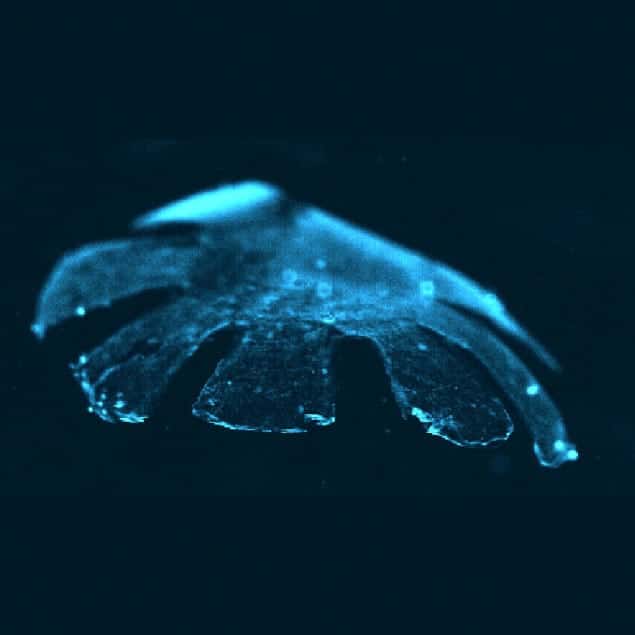
Scientists in the US have created an artificial jellyfish out of silicone and rat heart muscle cells. The creature, dubbed “Medusoid”, swims just like its living analogue by pumping water in and out of its dome-shaped body in rhythmic pulses. Ultimately, the researchers hope to apply the same reverse-bioengineering techniques to design better artificial hearts for medical implant.
The motivation behind this new work was borne out of team member Kevin Parker’s frustration with the state of the cardiac field. An applied physicist and bioengineer at Harvard University in the US, he worried that the drug-development pipeline for cardiac disease was “starting to look a little bit lean”.
“[Medicine is] kind of running out of ideas as to how to treat heart cellular problems,” he says, suggesting “We might just not understand the fundamental rules nature has for building a good muscular pump.”
On a trip to the aquarium, Parker was struck by the similarities between how jellyfish and the human heart pump fluid, and decided to try building a replica. It’s an unprecedented move, building an entire functioning organism, but Parker was adamant that he wanted to challenge the traditional view of synthetic biology that has thus far “focused on genetic manipulations of cells”.
Grow your own jellyfish
Jellyfish pump liquid to propel themselves through water by employing the same basic principles used by the human heart to pump blood around the body. Both use a smooth wave of muscular contractions to squeeze liquid quickly and forcefully from a cavity, which then refills slowly by elastic recoil. “In our engineered system, we needed to have these two components,” explains another team member John Dabiri, an expert in biological pulsing at the California Institute of Technology.
The team used rat cardiac cells, which were activated with a jolt of electricity, to provide the “power stroke”. These were arranged on a thin sheet of silicone polymer, which assumed the role of the jelly by slowly recovering the creature to its original shape ahead of the next stroke. Medusoid was built to resemble a juvenile moon jellyfish (Aurelia aurita). Less than a centimetre in diameter when flat, it possesses eight arm-like appendages that bend to give it a characteristic dome shape when it surges forward.
Morphologically and functionally, it’s a jellyfish; genetically it’s a rat Kevin Parker, Harvard University
In the quest to mimic the propulsion of real moon jellyfish, lead author of the paper on the new work published in Nature Biotechnology, Janna Nawroth, also at the California Institute of Technology, began by mapping the alignment of subcellular proteins in real specimens, using immunostaining – an antibody-based method used to detect a specific protein in a sample – techniques borrowed from forensic science. The blueprint she obtained was used to pattern the Medusoid’s silicone sheet with proteins and coax the rat cardiac cells into their desired arrangements upon it.
Looks like a jellyfish, swims like a jellyfish…
When the researchers put the Medusoid into salty water and applied an electric current, their creation proved to be as competent a swimmer as its real-life counterpart. Not only that – their detailed flow field measurements showed that the Medusoid had the mimicry down to such a fine art that it was even producing the same vortices that real jellyfish create at the end of each power stroke to sweep food up into their mouths. “We said – if we’re really good, we’ll be able to not just match the propulsion, we’ll be able to match the vortices of the feeding currents. And we were able to do that,” says Parker, adding “Morphologically and functionally, it’s a jellyfish; genetically it’s a rat.”
“I was surprised that with relatively few components – a silicone base and cells that we arranged – we were able to reproduce some pretty complex swimming and feeding behaviors that you see in biological jellyfish,” says Dabiri.
Landmark paper
Suwan Jayasinghe, a biophysicist from University College London who was not involved in the study, says the fact that the researchers managed to mimic the functionality and behaviour of the jellyfish in 3D is “unique” in a field where most people still focus on 2D systems. “There is no doubt that this is a landmark paper. The potential applications in humans are tremendous – it’s mind-blowing really.”
In the near future, the researchers hope that versions built with human heart cells could be used as an early screening device to study the effect of new heart drugs on pump function. In the longer term, they hope to build synthetic creatures with much more detailed musculature, and eventually to reverse-engineer a human heart. “This project is really just the beginning of what we see as a re-imagining of synthetic biology,” says Dabiri.
“Physicists really have a role to play here,” adds Parker. “Regenerative medicine is never going to be a possibility until we conquer the cell, and the cell is more of a physics problem than most people realize – it’s a microscale self-assembling self-fuelled system, and we need to understand the physics of the cell before we can use it as a building substrate.”
The work is published in Nature Biotechnology.



